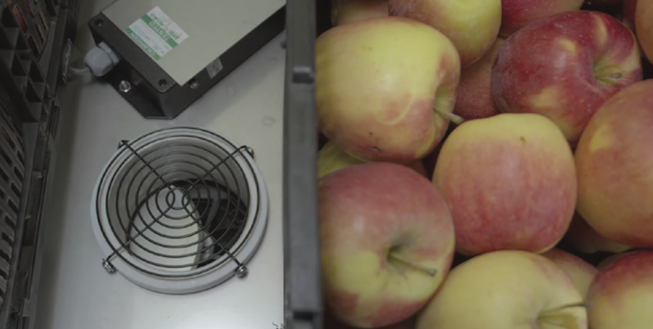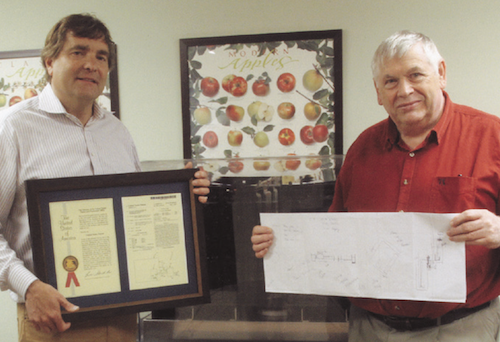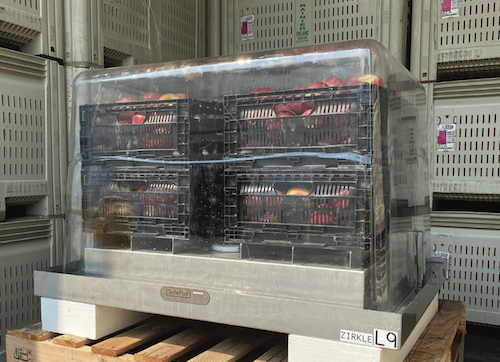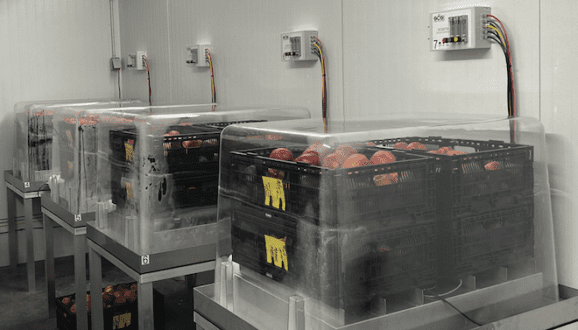

Jul 7, 2022SafePods offer peek into what’s going on in CA rooms
Storage Control Systems’ SafePods will be hitting several milestones this fall as apple growers fill controlled-atmosphere rooms: 10 million bushels will have been stored using the system, and the number of units will break the 300 mark for the first time.
At the same time, growers and university researchers will be learning more about the science of putting Mother Nature on hold to guard against apple disorders, browning, a shorter marketing window and other hurdles to bringing consumer-pleasing apples to market, no matter what month it is.
To use the SafePods, CA operators place four bushels of fruit from the storage room into the unit, and it acts as a smaller version of the storage room. SafePods allow CA operators to monitor the respiration rates of the fruit and dial in optimal conditions – too much oxygen leads to poor-quality fruit, and too little causes the fruit to ferment. The process is known as dynamic controlled atmosphere (DCA).
Before DCA was more established, apple varieties were stored according to guidelines established by universities, typically with 2.0%-2.5% oxygen.
“Now, research shows that using lower oxygen levels, sometimes as low as 0.4% oxygen, can be an effective way to control disorders like internal browning and bitter pit,” said Madison Schaefer, SafePod director at Storage Control Systems (SCS), Sparta, Michigan.


Her father, SCS president Jim Schaefer, said the system generates data that adds another dimension third to storing fruit, using oxygen and carbon dioxide levels to create an optimal respiration rate. He notes that as with many industries, apple shippers are losing institutional knowledge as CA operators retire.
“This respiration data allows a seasoned CA operator to verify what he has assumed and planned to store this crop, but more importantly the younger generation coming up the ranks have a phone app they can glance at and then get on with their day,” Jim Schaefer said.
Madison Schaefer said her generation values having the real-time data available through the app, but some companies are fine with scanning her weekly e-mail updates in which she details the data points for each CA room with the SafePod technology.


Conventional vs. Organic
Industry demand for the SafePods is about evenly split between conventional and organic, Madison Schaefer said. Organic fruit shippers embrace the system because chemical agents that halt the aging process in storage — diphenylamine (DPA) and 1-methylcyclopropene (1-MCP) — are not allowed for use on organic fruit.
For organic varieties that are susceptible to quality issues during long- term storage (Honeycrisp and Granny Smiths are prone to soft scald), perfecting a low-oxygen environment is critical.
“Some storages that I’ve worked with in Washington for the past four years started using SafePod on only their organic rooms, because they needed a way to prevent scald and extend storage life without the use of chemicals that are not organic certified,” Madison Schaefer said.
“Since then, they’ve gradually extended the use of SafePod to many conventional varieties as well, because the organic fruit was coming out of storage in better condition than their conventional fruit,” she said.


What’s behind door No. 2 … and doors 3-40?
Large-scale apple growers who store and then ship hundreds of thousands of bushels a year are constantly using educated guesses on which CA rooms to open next. When a shipper has up to 40 CA rooms to choose from, which one should be opened next?
“Following and comparing the respiration rate of each room is very telling of how sensitive apples are to changes in storage atmosphere,”
she said. “Respiration rate defines storability and can tell operators which room needs to be packed next. “Before, operators would use lot history, harvest date, and maturity going into storage to plan room opening order,” Madison Schaefer said. “Now, they appreciate having SafePod as an extra tool and clear view into the room to confirm the planned order is optimal. Or, the respiration data will inform them of a problematic lot or room they otherwise would have held longer in storage, sometimes saving them up to 25 times the investment of the SafePod in the room.”
During the hustle and bustle of harvest, growers are trying to get fruit into storage as soon as possible, and they aim to get fruit from the same block of trees into storage together. Grouping them together leads to a better chance of estimating when they should be released from CA.


A new variety, a new respiration rate
Different varieties need different levels of oxygen in storage, and stakeholders – growers, university horticulture departments as well as SCS – want to ensure varieties brought to market can hold up. Madison Schaefer said researchers are using the SafePods on the newer varieties. The company has been working with SnapDragon growers in New York, and Cosmic Crisp growers in Washington.
Some companies are using another SCS product, LabPod, which has hookups for oxygen, nitrogen and CO2 (if desired) so they can manipulate the environment, allowing for experimentation without putting an entire controlled-atmosphere room at risk.
Madison Schaefer recently talked with a pear grower in Hood River, Ore., who plans to learn about the low oxygen limit and respiration rate of a new variety with a SafePod unit. Other groups in the U.S. and elsewhere are using the system to collect respiration data on potatoes, cherries, avocados, mangos, kiwi, and cherry tomatoes, she said.
– Chris Koger, managing editor; Photos: Storage Control Systems














